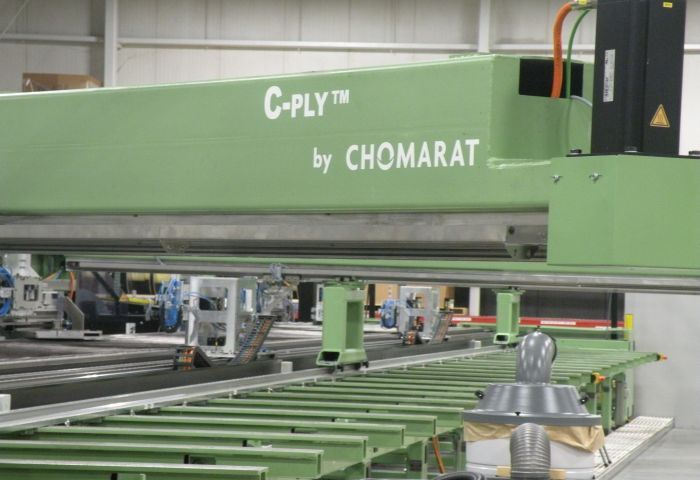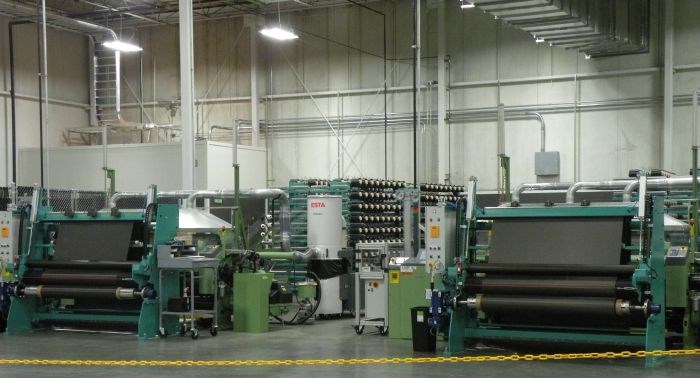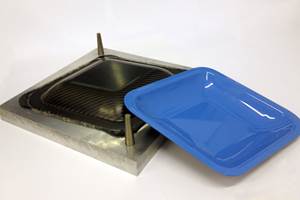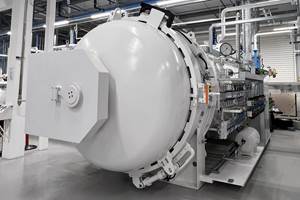Chomarat opens new C-PLY, C-WEAVE facility in South Carolina
New 58,000-ft2 plant in S.C. targets high-quality, high-performance solutions for aerospace and automotive applications.
Chomarat North America (Anderson, S.C.) held a ribbon cutting ceremony for its newest and third manufacturing facility in Anderson County, S.C. on Thursday, September 25th. Dedicated to textile solutions for advanced composite applications, the 58,000 ft2 manufactory features a LIBA MAX5 100-inch/2.5m (variable width) machine to produce thin-ply, carbon, spread-tow, multiaxial fabrics trademarked as C-PLY. These noncrimp fabrics (NCF) can exploit low-angle (e.g. 20° or 30°) plies and asymmetrical (or unbalanced) architecture to enable superior laminate strength while reducing processing cost compared to traditional quasi-isotropic (“black aluminum”) construction and autoclave cure. As will be exhibited at the upcoming Composite and Advanced Materials Expo (CAMX, Oct. 13-16, Orlando, Fla.), C-PLY has been demonstrated in the carbon fiber reinforced polymer (CFRP) VX1-KittyHawk blended wing body aircraft, which is advancing compressed natural gas (CNG) as an aviation fuel, and also in Roding Roadster CFRP roof structure, which uses polyurethane resin in a high-pressure resin transfer molding (HP-RTM) process to achieve a reported 6-minute cycle time with ready-to-paint surface for Class A finish directly out of the mold.
Chomarat Group (Le Cheylard, France) president, Florent Troubat, acquainted event attendees with the character of this company, established in 1898 and now operating on four continents with 1200 employees through a diverse set of strategic business units, including fashion and technical textiles, automotive interiors and composite reinforcements. Privately-owned by the Chomarat family, Troubat is part of the fourth generation whose goal is to build the company brand and pass this on to the next generation. He stressed the company’s decades-long customer relationships, focus on innovation and prudent management resulting in a strong business foundation.
Vision toward innovation
Chomarat Group managing director Michel Cognet gave the history of this advanced composites-dedicated facility, beginning in 2009 with a strategy decision to move beyond the company’s long history in high-quality fabrics for glass fiber and polyester composites, for example, common in marine construction. Investing €5 million in R&D and now $5 million in the new S.C. facility, Cognet commented, “We were a latecomer to the advanced composites industry, but we have high goals with regard to product quality and innovation.”
In an interview with CW later, Cognet noted that Chomarat is now the benchmark for quality, explaining: “Everyone makes the same carbon fabrics, but our quality can make a difference. Historically, there have been defects with woven fabric. However, we have developed technology to control quality so that our rolls are defect-free. For example, the way we introduce the yarns in our textile processes, there is no degradation or damage.” He also cited Chomarat’s unique ability to use 50k large tow carbon fiber to make 100 g/m2 fabrics with virtually no defects and noted this overall quality capability makes Chomarat advanced composite textiles ideal for the most demanding applications, including visual quality surfaces in automotive structures, for example. “In the U.S. we are starting with two looms and will soon add more,” Cognet explained to CW, “but in Europe and China we are producing on a large-scale and are already recognized as the leaders in quality.”
Finishing his introductory remarks during the opening ceremony, Cognet described the importance of his meeting with Dr. Stephen Tsai in 2010 and Chomarat’s understanding of the real innovation in Tsai's thin-ply, low-angle biaxial fabric ideas, now commercialized by Chomarat as C-PLY. Dr. Tsai praised Chomarat’s development and commitment over the past four years through proxy Bob Skillen, president of VX Aerospace (Morganton, N.C.). Specifically, he noted that the initial meeting was in October, and by December, Chomarat had delivered 600m/1,970 ft of bi-angle NCF to a prepregger. Cognet concluded his presentation by stating aerospace development has started this year and C-PLY will soon be flying on the Airbus (Toulouse, France) A320 single-aisle jetliner in a non-structural application.
Equipped to excel
After opening remarks, attendees toured the new facility, which featured two Dornier looms weaving R&D fabrics from 3k and 12k carbon tow and a spread-tow line which can process 12k to 50k tow. The latter was converting 24k tow into a 0.32mm/.013-inch thick, 150 g/m2 product, which was then beamed to feed into the C-PLY production line. Featuring three stations that can lay angled plies and a final station that lays 0° fiber, the LIBA MAX5 equipment can produce unidirectional up to quadraxial fabrics, held together by stitching only, without binder. Each ply can be customized from 75 to 300 g/m2. During the tour, the C-PLY line was processing +45°/-45° double bias carbon fabric for automotive wheels.
When CW asked Cognet how C-PLY will be used in automotive, he replied it has been used in fenders for the Audi RS3, enabling cost-effective large tow to be integrated as a 240 g/m2 fabric with excellent surface finish. “People think that the stitch yarn is an issue,” Cognet contends, “but the problem is the hole from the stitch that concentrates resin. With C-PLY we have no hole around the stitch and produce a very flat fabric.” In fact, the C-PLY offerings are touted as completely gap-free, a feat normal aerospace woven fabrics cannot yet claim.
The Audi RS3 CFRP fender was molded by Sora Composites (Laval, France), which was acquired in 2012 by Tier 1 supplier Faurecia (Nanterre, France). Faurecia North America (Auburn Hills, Mich.) has renovated a former Ford interiors plant in Saline, Michigan, and president Mike Heneka has told auto industry press that the Saline plant will use a proprietary manufacturing process to make carbon fiber parts viable for the U.S. market. Notably, Faurecia attended Chomarat’s new facility opening.
Related Content
PRF Composite Materials introduces RP570 FR eXpress cure prepreg system
Ultra-fast, fire-retardant formulation targets snap cure press molding of structural components.
Read MoreIndustrial composite autoclaves feature advanced control, turnkey options
CAMX 2024: Designed and built with safety and durability in mind, Akarmark delivers complete curing autoclave systems for a variety of applications.
Read MoreBusch expands autoclave solutions
Busch announces its ability to address all autoclave, oven and associated composites manufacturing requirements following the acquisition of Vacuum Furnace Engineering.
Read MorePlant tour: Airbus, Illescas, Spain
Airbus’ Illescas facility, featuring highly automated composites processes for the A350 lower wing cover and one-piece Section 19 fuselage barrels, works toward production ramp-ups and next-generation aircraft.
Read MoreRead Next
Modeling and characterization of crushable composite structures
How the predictive tool “CZone” is applied to simulate the axial crushing response of composites, providing valuable insights into their use for motorsport applications.
Read MorePlant tour: A&P, Cincinnati, OH
A&P has made a name for itself as a braider, but the depth and breadth of its technical aptitude comes into sharp focus with a peek behind usually closed doors.
Read More























